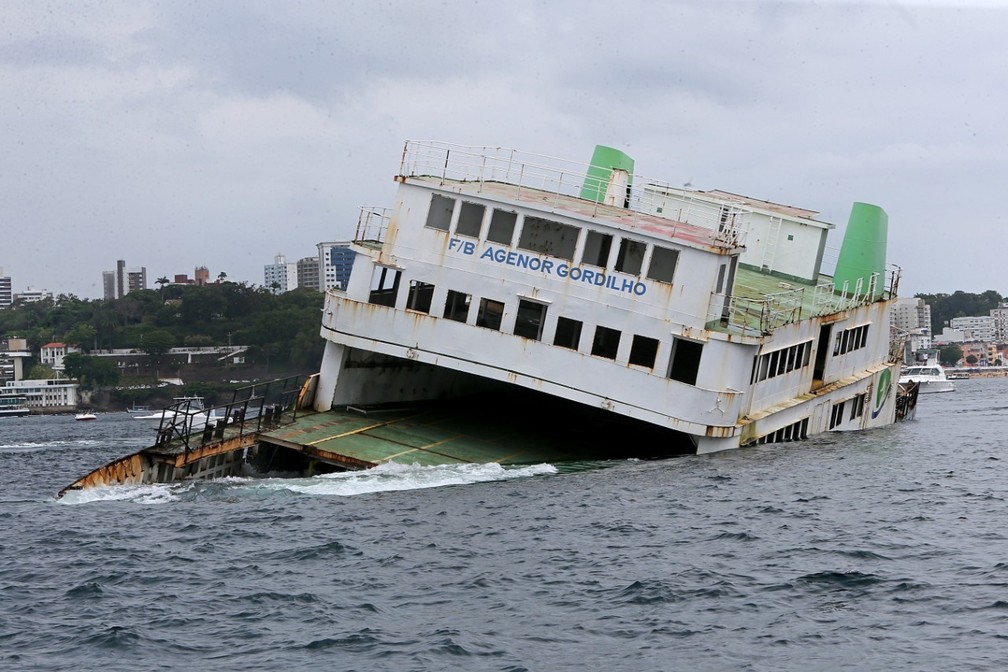RIO DE JANEIRO, BRAZIL – A ferry and a tugboat were sunk in the Todos-os-Santos Bay, near Salvador, on Saturday, November 21st. The sinking point is located 1.5 kilometers off the coast.
The two vessels will be used for underwater tourism in the state. This was the first time that a ferry was sunk at the site. The Navy and the Environment Secretariats (INEMA), Infrastructure (AGERBA) and Administration (Heritage) were involved in the action, as well as SETUR (Tourism Secretariat).

According to the state government, diving activities are expected to be conducted at the site next week. The sinking of the ferry boat, by opening the floodgates for water inflow, began at around 12 noon and took about an hour. Then the Vega tugboat was sunk.
The Agenor Gordilho ferry – 71 meters long and 19 meters tall – and the Vega tugboat were going to be scrapped after operating for about five decades, but were ultimately converted into diving sites and artificial reefs.
In order to enable the sinking, prior studies on location and environmental impacts were conducted. Oils and fuels from the vessel were removed to meet environmental specifications, as well as parts that posed risks to future divers.
The work was fully conducted in accordance with international and Brazilian Navy standards.
“Regarding safety, contamination and risk of cuts, accidents of this kind, the ferry boat was, both the Agenor and the Vega, completely cleaned, all the piping was removed, everything where some kind of liquid or oil had passed through, the engines were removed, larger areas were opened to ease the displacement inside the vessels,” said Rodrigo Maia Nogueira, a diving instructor.
The vessels will lie at a depth of between 30 and 35 meters, ensuring good access starting at 15 meters for beginner divers.
Underwater tourism
According to the State Secretary of Tourism Fausto Franco, the initiative can help raise more funds for the state, since tourists typically extend their trips when there are more attractions and activities happening in the city.
“This will enable a new perspective of underwater tourism, which exists in the world but we have explored very little here in the Todos-os-Santos Bay, the second-largest in the world. We believe that in less than a year marine life will settle in these vessels and people will now be able to enjoy it starting this week, taking all the precautions that assisted diving tourism demands”, he says.
The secretary also said that all rules have been followed to ensure environmental safety.
“All the environmental norms have been respected. The INEMA together with the Navy monitored the last inspections all week. So the ecological aspect, which is crucial and indispensable, was respected. All the safety norms were met,” he details.
For Francisco Kelmo, director of the Institute of Biology of the Federal University of Bahia (Ibio/Ufba), this initiative is positive for marine biodiversity.

“We have no prospect of a negative impact, only positive impacts for the environment. Once this structure is sunk, it will serve as a substrate so that several invertebrate organisms can use this structure for settlement. There they will settle, develop, begin a whole life. And when this community is established, it will be bait for several fish,” he said. In terms of biodiversity, it is a very interesting strategy. Artificial reefs are already being used in several parts of the world,” he explains.
According to diver and photographer Roberto Costa Pinto, this is an opportunity for the Todos-os-Santos Bay, which is the largest in the country and the second-largest in the world, after the Gulf of Bengal.
“This is a unique opportunity for the Todos-os-Santos Bay to gain national and international visibility. It’s a great moment for us all and these two diving points will be a great teaching point, a recreational, technical and scientific diving classroom,” he said.
Source: G1

